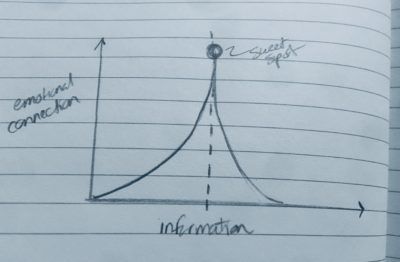Here’s my 2019 reset —
If you want your video to reach its intended audience with the intended result, then forget about leading… too much.
Every commercial, corporate video, brand communiqué, all have something in common, beyond the fact that they are all developed to convey a message to an the intended audience. They all have the potential to reach a magical point in communication, where the audience fills in the blanks, completes the sentence, connects the dots between their lives and the content of the communication. The point where there is a connection made between the message and the viewer.
During one of my recent internet ad scouring sessions (for emotionally charged ads), I’ve encountered a number of commercials that go beyond that magical point, beyond the point where there is an assumed understanding/emotional connection — one stop short of blatantly telling the viewer what to feel. For creative video, including corporate video communications, this ruins the experience for the viewer, effectively lessening the impact of the message. And the whole point to producing video that evokes an emotional response is to stimulate action based on that message (this is not new). No response or connection means no action.
Snowboarding analogy: It’s like getting to the top of a lift, then being told which run you have to go down. They (the runs) all end up at the same spot, but the journey is different for each route. Taking away the ability to choose a route takes away the excitement of having a truly unique experience (as it is tainted by someone else’s opinion).
Back to commercial video; leading the viewer too much takes away their choice of how, or what, they feel from the whole experience. Any parent knows that when you remove the ability to choose between A and B, by subtly telling a child which one they should choose, more often than not, they will choose the opposite.

Figure 1. Relationship between Emotional Connection and Information provided through video.
So there is a relationship between amount of information, emotional connection and the desired response. Just enough equals a viewer connection which has the potential for action, too much equals a reduced connection and less chance of action, and that relationship is a knife edge.
Without telling someone that his or her baby is ugly, I’ll try to explain.
Here’s the gist of one of the commercials I made reference to above: Dad has a disease that will shorten his lifespan considerably (this was set up in the opening scenes). Girl looks up at her Dad with an expression of sadness in her eyes. Just before the copy is flashed on the screen asking for help to find a cure, the Girl asks the question: “Dad, are you going to die?”
My thoughts: Was that really necessary? Yes, he is. We know that because that was already set up in the opening scene. Now, if we are trying to evoke an emotional response, a genuine look of sadness coupled with the previous message about the certainty of a shortened life span, does just that. Having the Girl ask the question speaks more to the person who has the disease rather than those that don’t (my assumption here is that the intended audience is for those that do not). Fact: people cannot understand what those with disease truly feel if they do not suffer from that same disease, but they can understand the feelings they have themselves when their son or daughter looks up at them with tears in their eyes.
As creatives we need to resist the urge to tell people outright how we want them to feel by leading them too much (and I have done my share of this), and let people come to that conclusion on their own. The viewer’s journey is what will carry the message. That should be our guiding principle going into 2019.
A fantastic ad, in my opinion, that is able to make the viewer feel a sliver of what the main character feels, by guiding them without a word spoken, is P&Gs “Thank you, Mom”, directed by Alma Har’el for Wieden & Kennedy Portland.
So, for 2019 lets all try to lead through creative interpretation, and not the text of the brief that we are working from.
Thank you Alma.


